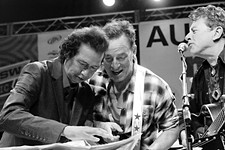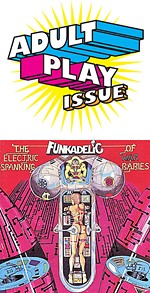Ki ho`alu
Dancing Cat's Slack Key Guitar Series
By Margaret Moser, Fri., Aug. 23, 1996
Of all the modern musical traditions in Hawaii, ki ho`alu, or slack key guitar, is perhaps the most pervasive. Slack key guitar is exactly what it sounds like, ki ho`alu, a "loosening of the keys" on the instrument's neck, coupled with open-chord tunings, embellished harmonics, and fingerpick techniques. Leave it to the Hawaiians -- a culture plundered by both the East and West as well as various religious groups -- to reduce guitar playing to simple fundamentals, then re-invent it with flair.
Almost everything we consider "Hawaiian music," then, is a recent invention, and interestingly, its roots lie with the Spanish/Portugese and Mexican/Californian immigrants who came to the Islands in the 1880s. Though the guitar's appearance in the islands is unrecorded, it's likely the instrument was brought by one of these groups, who also introduced the ukulele. Slack key's Hispanic roots are perhaps why the style's flourishes are so reminiscent of flamenco.
Nothing did more (or less) for Hawaiian music than the tourist boom in the early decades of this century, when Matson steamliners brought droves of visitors to frolic on the beaches of Waikiki. National live broadcasts of radio programs like "Hawaii Calls" sent the palm-tree sway of Island life into the homes of Americans on a weekly basis. The Islands' PR machinery painted portraits of a modern paradise with bronzed young men riding the surf and glossy-haired beauties undulating in the balmy breezes, and the American public loved it. For all its picturesque qualities, nothing was more evocative of the Islands than its music and "Hawaiian music" became a trend.
If the perky pluck of ukulele strings and gentle steel fairly screamed "Hawaii", the languid style of slack key guitar playing said the same in a quiet whisper. It became the style of choice at parties and luaus, often simply because it lent itself to improvisation. Slack key also developed several distinct forms, from folkie leanings to pronounced jazz stylings. Still, it might have remained just a musical sub-genre indigenous to Hawaii were it not for a guitarist named Gabby Pahinui.
Gabby "Pops" Pahinui was the first player to record slack key guitar in the mid-Forties, followed by Leonard Kwan and Sonny Chillingworth in the Fifties and Ray Kane and Atta Isaacs in the Sixties. (Both Kwan and Kane have played the Cactus Cafe.) All across the islands, slack key emerged as the favored style, but it was Pahinui who gave it personality. A resident of the Wainae coast of Oahu, Gabby Pahinui worked for the City of Honolulu as a roadworker but come the weekends, friends and family would gather for the pleasure of his music. As Hawaii entered the union as a state in the late Fifties, the langorous, lulling beauty of slack key emerged as the perfect accompaniment to a new era.
But slack key guitar -- and other traditional forms of music -- nearly died out in the Sixties in Hawaii because of yet another kind of Western invasion: rock & roll. Young people on the Islands fell for its rhythms as did their counterparts on the Mainland, and even tourists seemed more interested in novelty tunes. Out went heritage and in came "go-cat-go." Still, rock & roll's conscience acknowledges its own sense of tradition eventually, its myriad cultural influences periodically rising to the surface. In the late Sixties and early Seventies, a renewal of interest in Hawaii's heritage took place, and the once old-fashioned sound of slack key now became a treasured artform.
Leading the Seventies "Hawaiian Renaissance" was Pahinui, who had caught the attention of Ry Cooder; Cooder tapped Pahinui to record with him, even naming the album Chicken Skin Music, a reference to music so haunting it causes the listener to break out in goosebumps. Pahinui, Kwan, Chillingworth, and Isaacs were joined by players like Peter Moon, Keola Beamer, Ledward Kaapana, Reverend Dennis Kamakahi, and George Kuo, as well as Pahinui's sons, Martin, Bla, and Cyril. It may have been a bastard form of music played on imported instruments with technique imitated, but there was no question that slack key was now considered as Hawaiian as the Islands' white sand beaches. When Gabby Pahinui died in 1987, the time seemed right to archive the recordings.
In 1994, George Winston's Dancing Cat Records began releasing a series called "Hawaiian Slack Key Guitar Masters Series" that included releases by Ray Kane, Cyril Pahinui, Ledward Kaapana, and Sonny Chillingworth, who died that year. Releases continued in 1995 with CDs from Moses Kahumoku, Leonard Kwan, Ozzie Kotani, and Keola Beamer, followed in 1996 by George Kuo and Reverend Dennis Kamakahi. In addition, the label released an album of acoustic steel and slack key duets from Barney Isaacs and Kuo, and a narrative history disc with a number of the musicians talking about and playing slack key guitar.
The beauty and range of slack key is remarkable, as these gorgeously produced discs attest in vocal and pure instrumental styles. Hawaiian music may still be thought of as Don Ho schlock but this series of recordings reveals a tradition far removed from that stereotype. Ha'ina `ia mai ana ka puana. And now my story is told.








